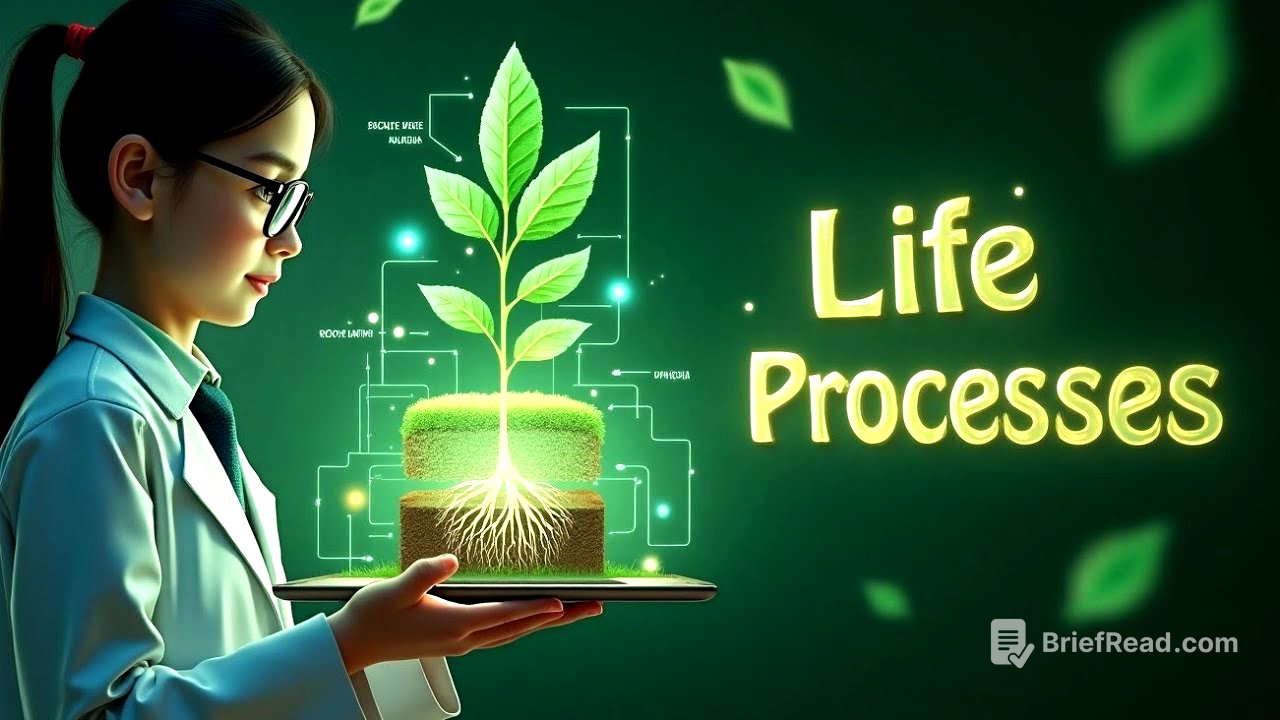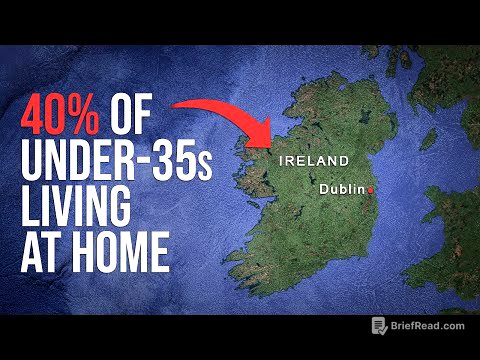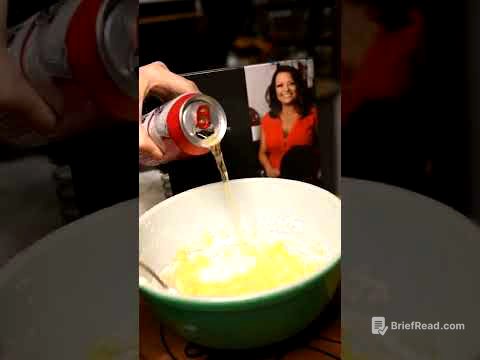TLDR;
This video provides a comprehensive overview of the chapter "Life Processes" for 10th-grade science, covering essential functions that living organisms perform to sustain life. It explains nutrition (autotrophic and heterotrophic), respiration (aerobic and anaerobic), transportation (in humans and plants), and excretion (in humans and plants).
- Nutrition: Autotrophic and heterotrophic types, photosynthesis in plants, and holozoic nutrition in humans.
- Respiration: Aerobic and anaerobic processes, differences between breathing and respiration, and respiration in plants and humans.
- Transportation: The roles of blood, blood vessels, and the heart in humans, and xylem and phloem in plants.
- Excretion: Waste removal in humans (kidneys and nephrons) and plants (gaseous, liquid, and solid waste).
Introduction to Life Processes [0:00]
The video introduces the chapter on life processes, emphasizing its importance for the class 10th exam. Life processes are defined as the basic functions that living organisms perform to maintain their life on Earth. The four main life processes discussed are nutrition, respiration, transportation, and excretion.
Nutrition: Types and Processes [0:38]
Nutrition is the process of taking food and converting it into energy and essential nutrients. There are two types of nutrition: autotrophic and heterotrophic. Autotrophic nutrition involves organisms making their own food, like green plants through photosynthesis. Heterotrophic nutrition involves organisms depending on other organisms for food and includes saprophytic, parasitic, and holozoic nutrition. Saprophytic nutrition involves feeding on dead organic matter (e.g., fungi), parasitic nutrition involves deriving nutrition from a host (e.g., lice), and holozoic nutrition involves ingesting solid food (e.g., humans). Holozoic nutrition occurs in five steps: ingestion, digestion, absorption, assimilation, and egestion.
Photosynthesis in Plants [3:10]
Plants make their food through photosynthesis, converting light energy into chemical energy. The chemical reaction involves carbon dioxide and water forming glucose and oxygen in the presence of sunlight and chlorophyll. The three main steps of photosynthesis are: absorption of light energy by chlorophyll, conversion of light energy into chemical energy and breakdown of water molecules, and reduction of carbon dioxide into carbohydrates. Chlorophyll, the green pigment in plants, is found in chloroplasts within the leaves and facilitates this conversion. Gas exchange in leaves occurs through stomata, controlled by guard cells.
Holozoic Nutrition and Nutrition in Amoeba [4:55]
Holozoic nutrition is completed in five steps: ingestion (taking in food), digestion (breaking down food), absorption (absorbing nutrients), assimilation (using absorbed nutrients for energy), and egestion (eliminating waste). In amoeba, nutrition involves sensing food, using pseudopodia to surround the food, secreting enzymes to digest the food in a food vacuole, absorbing and assimilating the digested food for energy, and finally, egesting the remaining waste.
Nutrition in Human Beings [6:12]
Nutrition in human beings is primarily carried out through the human digestive system, which includes the alimentary canal and associated glands (salivary glands, liver, and pancreas). The alimentary canal consists of the mouth, esophagus, stomach, small intestine, and large intestine. Digestion begins in the mouth with teeth crushing the food and salivary amylase breaking down starch. The food then passes through the esophagus to the stomach, where gastric glands secrete gastric juice containing pepsin (for protein digestion), hydrochloric acid (HCl) (to activate pepsin), and mucus (to protect the stomach lining).
Digestion in the Small Intestine and Waste Elimination [8:22]
In the small intestine, bile juice (from the liver) emulsifies fats, and pancreatic juice (from the pancreas) digests proteins (with trypsin), fats (with lipase), and carbohydrates (with amylase). Intestinal juices complete the final digestion. The digested food is absorbed in the small intestine with the help of villi. The waste material then moves to the large intestine, where water is absorbed, and the remaining waste is expelled through the anus.
Respiration: Definition and Types [9:44]
Respiration is the process of releasing energy from food, distinct from breathing, which is the exchange of gases. Breathing involves taking in oxygen and expelling carbon dioxide. Respiration occurs inside all cells and is a chemical process, releasing energy in the form of ATP. There are two types of respiration: aerobic and anaerobic. Aerobic respiration breaks down food in the presence of oxygen, yielding 38 ATP molecules and producing carbon dioxide and water. Anaerobic respiration occurs without oxygen, yielding only 2 ATP molecules and producing carbon dioxide and ethyl alcohol or lactic acid.
Aerobic vs. Anaerobic Respiration and Energy Release [11:26]
Aerobic respiration occurs in the cytoplasm and mitochondria, completely breaking down glucose and releasing 38 ATP. ATP (adenosine triphosphate) is the energy currency of the cell. Anaerobic respiration occurs only in the cytoplasm, incompletely breaking down glucose and releasing only 2 ATP, along with CO2 and ethyl alcohol or lactic acid. A flowchart illustrates the breakdown of glucose into pyruvate in the cytoplasm, followed by different pathways based on the presence or absence of oxygen.
Respiration in Plants [14:05]
Respiration in plants involves gaseous exchange and the release of energy. Gas exchange occurs through stomata in leaves, lenticels in stems, and root hairs in roots. Plants break down glucose to form carbon dioxide and water. Both photosynthesis and respiration occur in plants, but photosynthesis is much higher during the day. At night, only respiration occurs, leading to the release of CO2.
Respiration in Human Beings [15:49]
In the human respiratory system, air enters through the nostrils, which filter out dust particles. The air then passes through the larynx to the trachea, which delivers air to the lungs. The lungs contain bronchi, bronchioles, and alveoli. Oxygen reaches the alveoli during inhalation, where gas exchange occurs. Oxygen dissolves in blood vessels and binds with hemoglobin to form oxyhemoglobin, which is transported to all cells. CO2 from the blood enters the alveoli and is expelled during exhalation. The chest cavity expands during inhalation and contracts during exhalation.
Transportation: Components and Functions [18:14]
Transportation involves the movement of substances (food, gases, water, tissues, hormones) from one place to another inside the body. In humans, transportation involves blood, blood vessels, and the heart. Blood is a fluid connective tissue composed of plasma, red blood cells (RBCs), white blood cells (WBCs), and platelets. Plasma is a straw-colored fluid containing water, proteins, vitamins, and minerals. RBCs contain hemoglobin and transport oxygen. WBCs defend against infection. Platelets aid in blood clotting. Blood vessels (arteries, veins, and capillaries) are the channels through which blood flows.
Blood Vessels and the Human Heart [20:22]
Arteries transport oxygenated blood from the heart to the body, while veins transport deoxygenated blood back to the heart. Pulmonary arteries and veins are exceptions. Capillaries are the smallest blood vessels that facilitate substance exchange. The heart, composed of cardiac muscles, has four chambers: two atria and two ventricles, separated by the septum. Valves ensure one-way blood flow. The pericardium protects the heart.
Working of the Heart and Double Circulation [23:02]
Deoxygenated blood enters the right atrium, flows to the right ventricle, and is pumped to the lungs through the pulmonary artery. In the lungs, CO2 is removed, and the blood is oxygenated. Oxygenated blood returns to the left atrium through the pulmonary vein and is pumped to the body through the aorta. This double circulation involves blood passing through the heart twice. The heart pumps approximately 5 to 7 liters of blood per minute, normally beating 70 to 80 times per minute.
Transportation in Plants: Xylem and Phloem [25:37]
In plants, water, minerals, and food are transported. Water and minerals are absorbed from the soil through the roots and transported to different parts of the plant. Food is prepared in the leaves and transported to developing parts. Xylem transports water and minerals unidirectionally from the roots upwards, driven by physical forces like transpirational pull. Phloem transports food bidirectionally, both upwards and downwards, using energy in the form of ATP.
Excretion: Waste Removal in Humans [27:18]
Excretion is the biological process of removing harmful nitrogenous metabolic waste from the body. In humans, waste forms include digestive waste, respiratory waste, and nitrogenous waste. The human excretory system includes a pair of kidneys, a pair of ureters, a urinary bladder, and a urethra. Kidneys filter blood and drain urine into the urinary bladder, where it is temporarily stored and released through the urethra.
Kidney Function and Nephron Structure [29:07]
Blood enters the kidneys through the renal artery, is filtered, and returns to the body through the renal vein. Urine reaches the urinary bladder through the ureter. The kidney contains nephrons, which are filtration units. Each kidney has approximately 1.2 million nephrons. The nephron includes a Bowman's capsule, which filters the blood and collects urine, and a Henle loop, which reabsorbs glucose, amino acids, and water. The urine is then carried to the urinary bladder through the ureter.
Excretion in Plants [31:07]
Plants excrete gaseous waste through stomata during respiration, liquid waste through transpiration (mainly water), and solid waste by separating old leaves and bark from their body.









